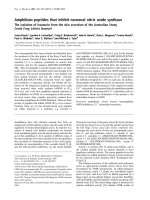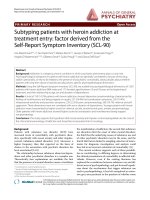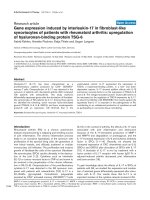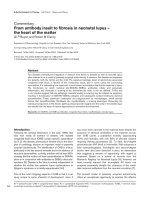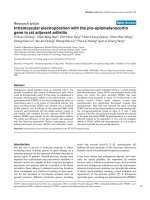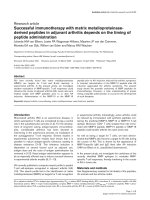Báo cáo y học: " Secondary infection with Streptococcus suis serotype 7 increases the virulence of highly pathogenic porcine reproductive and respiratory syndrome virus in pigs" potx
Bạn đang xem bản rút gọn của tài liệu. Xem và tải ngay bản đầy đủ của tài liệu tại đây (1.03 MB, 9 trang )
RESEARC H Open Access
Secondary infection with Streptococcus suis
serotype 7 increases the virulence of highly
pathogenic porcine reproductive and respiratory
syndrome virus in pigs
Min Xu
1,2
, Shujie Wang
1†
, Linxi Li
3
, Liancheng Lei
3†
, Yonggang Liu
1
, Wenda Shi
1
, Jiabin Wu
3
, Liqin Li
1
,
Fulong Rong
4
, Mingming Xu
4
, Guangli Sun
4
, Hua Xiang
2
, Xuehui Cai
1*†
Abstract
Background: Porcine reproductive and respiratory syndrome virus (PRRSV) and Streptococcus suis are common
pathogens in pigs. In samples collected during the porcine high fever syndrome (PHFS) outbreak in many parts of
China, PRRSV and S. suis serotype 7 (SS7) have always been isolated together. To determine whether PRRSV-SS7
coinfection was the cause of the PHFS outbreak, we evaluated the pathogenicity of PRRSV and/or SS7 in a pig
model of single and mixed infection.
Results: Respiratory disease, diarrhea, and anorexia were observed in all infected pigs. Signs of central nervous
system (CNS) disease were observed in the highly pathogenic PRRSV (HP-PRRSV)-infected pigs (4/12) and the
coinfected pigs (8/10); however, the symptoms of the coinfected pigs were clearly more severe than those of the
HP-PRRSV-infected pigs. The mortality rate was significantly higher in the coinfected pigs (8/10) than in the HP-
PRRSV- (2/12) and SS7-infected pigs (0/10). The deceased pigs of the coinfected group had symptoms typical of
PHFS, such as high fever, anorexia, and red coloration of the ears and the body. The isolation rates of HP-PRRSV
and SS7 were higher and the lesion severity was greater in the coinfected pigs than in monoinfected pigs.
Conclusion: HP-PRRSV infection increased susceptibility to SS7 infection, and coinfection of HP-PRRSV with SS7
significantly increased the pathogenicity of SS7 to pigs.
Background
Porcinereproductiveandrespiratorysyndrome(PRRS)
is a threat to the swine industry, and has spread globally
to almost every country involved in pig farming, with a
few exceptions like Sweden, Switzerland, New Zealand,
and Australia [1-4]. PRRS mainly affects pigs and sows;
it mainly causes premature delivery, miscarriage, still-
birth, and mummies in sows, and severe pneumonia,
edema, and conjunctivitis in pigs. Previous studies have
shown that coinfection of PRRSV and bacteria, such as
Streptococcus suis, aggravates PRRS [5]. It has been
confirmed that PRRSV-infected pigs are more suscepti-
ble to S. suis serotype 2 (SS2) infection, and the mortal-
ity rate of coinfected pigs is significantly higher than
that of PRRSV infected pigs. While the clinical symp-
toms of both PRRSV infected and coinfected pigs were
similar, the incidence of fever in coinfected pigs was
higher than that in monoinfected pigs [6].
Since 2006, an unprecedented epidemic of porcine
high fever syndrome (PHFS) has spread through the
Chinese swine industry, resulting in the culling of an
estimated 20 million pigs annually. This disease is char-
acterized by high fever, high incidence rate, and high
mortality rate [7]. After extensive epidemiological inves-
tigations, highly pathogenic PRRSV (HP-PRRSV) was
first isolated from China; many reports suggested that
an NSP2 and GP5 gene deletion mutant of PRRSV was
the causative agent of the PHFS epidemic [7-10]. Since
* Correspondence:
† Contributed equally
1
Division of Swine Infectious Diseases, National Key Laboratory of Veterinary
Biotechnology, Harbin Veterinary Research Institute, CAAS, Harbin 150001,
China
Full list of author information is available at the end of the article
Xu et al. Virology Journal 2010, 7:184
/>© 2010 Xu et al; lice nsee BioMed Central Ltd. This is an Open Access article distributed und er the terms of the Creative Commons
Attribution Lice nse (http://c reativecommons.org/licenses/by/2.0), which permits unrestricted use, distribution, and reproduction in
any medium, provided the original work is properly cited.
SS7 has been isolated from pigs exhibiting clinical symp-
toms of PHFS, some researchers also believe that PHFS
is caused by coinfection of HP-PRRSV and S. suis. SS7
is more prevalent than other S. suis serotypes in several
provinces of China [11,12], and SS7 exacerbates PHFS
when accompanied by PRRSV infection. Other research-
ers have suggested that SS7 is less virulent than SS2 and
cannot induce serious effects. We established a porcine
model of single and mixed infection using veterinary
clinical isolates of PRRSV strain HuN4 and SS7 strain
WC0711 isolated from China, based on the protocol for
coinfection model establishment proposed by Harms et
al. [13]. Our aim was to characterize the interaction of
SS7 with HP-PRRSV and to elucidate the causes of
PHFS epidemic.
Results
Clinical Observation
The pigs in HP-PRRSV-infected group and coinfected
group had rectal temperatures > 40.5°C for more dura-
tion than control pigs and SS7-infected pigs. Among the
coinfected pigs, 8 died of acute illness and the remaining
2 survived. The mortality and morbidity rates of pigs in
all groups are summarized in Table 1. The severity of
respiratory disease in HP-PRRSV-infected and coinfected
pigs was significantly higher (P < 0.05) than in control or
SS7 monoinfected pigs. The HP-PRRSV-infected and
coinfected pigs with respiratory disease had cough and
sneezing in the e arly phase and asthma and abdominal
breathing thereafter. The SS7-infected pigs exhibited
mild and moderate cough and sneezing symptoms in the
early phase, but they recovered within 2 or 3 days. The
HP-PRRSV-infected (4/12) and coinfected pigs (8/10)
showed signs of central nervous system (CNS) disease,
including muscle tremors, head tilt, nystagmus, and pos-
terior limb paralysis. Only 1 pig in t he coinfected group
exhibi ted joint swelling. These signs of CNS disease were
notobservedinSS7-infectedpigs.UnlikeSS7-infected
pigs, all pigs in the HP-PRRSV-infected and coinfected
groups exhibited athrepsia. Further, conjunctivitis was
observed in HP-PRRSV-infected pigs and coinfec ted pigs
and diarrhea was observed in HP-PRRSV-infected pigs
(severe), SS7-infected pigs (temporary), and coinfecte d
pigs (severe). The relevant clinical data are shown in
Table 2.
Macroscopic and microscopic lesions
No macroscopic lesions were observed in the con trol
pigs. The pigs in HP-PRRSV-infected and coinfected
groups developed macroscopic b rain lesions mainly due
to meningitis, meningeal congestion and hemorrhage,
swallowed gyri, and brain tissue colliquation. The lung
lesions showed multifocal distribution. The affected lung
parenchyma appeared mottled, tan, and rubbery, and
failed to collapse. Several pigs in the coinfected group
had p leuritis or purulent airway exudates. The severity
of t he lung lesions in S S7-infected pigs was lower than
that in HP-PRRSV-infected and coinfected pigs. Pigs in
all the 3 experimental groups showed lymph node
lesions, including intumescentia and hemorrhage. The
scores of lung and lymph nodes were evaluated in detail
at necropsy, and are summarized in Figure 1. Kidney
lesions in HP-PRRSV-infected and coinfected pigs
included punctiform hemorrhage in the cortex, inner
hemorrha ge, shrunken or disappeared substantia medul-
laris, and change of color to cinnamon. Macroscopic
lesions were also detected in other organs in HP-
PRRSV-infected and coinfected pigs; these pigs had
grayish-white spots in the liver, and trichocardia,
hydrops pericardial, tonsillitis, hemorrhage of the sto-
mach fundus, and spleen infarcts. The SS7-infected pigs
had macroscopic lesions mainly in the lungs and lymph
nodes with few lesions in other organs. Peritonitis was
observed in SS7-infected pigs ( 2/10) and coinfected pigs
(4/10). There was no evidence of a rthritis in any of the
pigs. The representative images of the macroscopic
lesions are presented in Figure 2.
The control pigs showed no pathological lesions. The
pathological lung lesions in HP-PRRSV-infected pigs
showed the following characteristics: widened interval of
alveolar and mild interstitial pneumonia on day 7; inter-
stitial pneumonia associated with purulent lesions and
small vessel thrombosis on day 14; suppurative pneumo-
nia and purulent bronchitis on day 21; and localized
interstitial pneumonia on day 28. The pathological lung
lesions in SS7-infected pigs showed the following
Table 1 Mortality and morbidity rates of each group
Group no.
(n)
Designation Pigs Deaths* Mortality Morbidity
Number DPI
1(8) Control 0 0%
a
0%
a
2(12) PRRSV 1 13 16.7%
b
100%
b
121
3(10) SS7 0 0%
a
70%
b
4(10) ** PRRSV+SS7 1 10 80%
c
100%
b
212
313
215
*: Number of pigs and days post inoculation (DPI) when they were euthanized
or died due to infection.
**: Two pigs were necropsied on day 7 (when the pigs were not inoculated
with SS7).
a, b, c Values with different superscripts are significantly different (P < 0.05) as
determined by Fisher’s exact test.
Xu et al. Virology Journal 2010, 7:184
/>Page 2 of 9
characteristic s: widened alveolar septa with neutrophil
suppurative lesions and small vessel thrombosis on day
14 (7 days after inoculation); widened alveolar septa
accompanied by a small number of lymphoid cells, eosi-
nophil infiltration with some fibrin deposition, and mild
interstitial pneumonia with neutrophil infiltration on
day 21; and small amount of lymphocytic infiltration,
fibroplasia, small vessel thrombosis and extensive loca-
lized interstitial lymphoid cell infiltration around the
bronchi o n day 28. The pathological lung lesions in all
of the 8 deceased pigs (death occurred between days 10
and 15) exhibited suppurative pneumonia , purulent
bronchitis, thrombosis, blood stasis, and widened alveo-
lar septa with fibrin deposition. The severity of the
lesions in the deceased pigs was significantly higher (P <
0.01) than that in HP-PRRSV-infected pigs on day 14.
The 2 surviving pigs showed localized interstitial pneu-
monia on day 28. Their lymph nodes exhibited marked
lymphocyte necrosis and disintegration, which was
sometimes combined with plasma cell hyperplasia or
eosinophil infiltration, elevated nodule volume, nodule
cavitation, and paracortical hemorrhage. The lymph
nodes of HP-PRRSV-infected and coinfected pigs
showedaconsiderabledegreeofinjurywithnosignifi-
cant difference, but were obviously more serious (P <
0.01) than those in the SS7-infected pigs. The specific
pathology scores of microscopic lung and lymph nodes
are summarized in Figure 1. The pathological examina-
tion of the brain of PRRSV- and SS7-infected pigs
mainly revealed small vessel thrombosis, mild edema,
neuron liquefaction necrosi s, and glial cell infiltration
and perivascular cuffing in some pigs. However, serious
Table 2 Respiratory disease scores and clinical signs
Group no.(n) Designation Respiratory disease scores CNS disease Diarrhea Athrepsy Bacteremia Viremia
1(8) Control 0.0 ± 0.0
a
0/8
a
0/8
a
0/8
a
0/8
a
0/8
a
2(12) PRRSV 1.8 ± 0.3
b
4/12
b
5/12
b
11/12
b
12/12
b
3(10) SS7 1.0 ± 0.2
c
0/10
a
7/10
b
0/10
a
0/10
a
4(12) PRRSV+SS7 2.1 ± 0.4
b
0/2,8/10
c
0/2,7/10
b
0/2,10/10
b
10/10
b
12/12
b
a, b, c, Values with different superscripts are significantly different (P < 0.05) a s determined by Fisher’s exact test.
Figure 1 Mean value (standard deviation) of lesion scores. (a) Scores of macroscopic lung lesio n, (b) Scores of macroscopic lymph node
lesion, (c) Scores of microscopic lung lesion, and (d) Scores of microscopic lymph node lesion at different times after inoculation.
Xu et al. Virology Journal 2010, 7:184
/>Page 3 of 9
perivascular cuffing and thrombosis were observed in
the pathological specimens of coinfected pigs. The
representative images of the microscopic lesions are pre-
sented in Figure 3.
Bacteremia and viremia
Bacteremia was observed in all 10 pigs of the coinfected
group, 2 of which showed persistent bacteremia during
the experiment. No bacteremia was observed in SS7-
infected pigs. At 3 days after HP-PRRSV infection, vire-
mia was observed in all pigs of the HP-PRRSV-infected
and coinfected groups, and 9 pigs had viremia even on
day 1. Except 5 pigs, all pigs had viremia throughout the
study.
Organ-wise distribution of virus and bacteria
The HP-PRRSV strain HuN4 and SS7 strain WC0711
were not detected in the organs of the control pigs. The
distribution status of HuN4 and WC0711 strains in 9
organs at different time points after inoculation is sum-
marized in Tables 3 and 4. WC0711 strain detection
rates in the 9 organs of the 8 deceased pigs in the c oin-
fected group were significantly higher (P < 0.05) than
those in SS7-infected pigs at all time points after
inoculation, except in the liver and tonsils on day 28.
HuN4 strain detection rates in the brains and stomachs
of coinfected pigs were significantly higher (P < 0.05)
than those in HP-PRRSV-infected pigs, while the detec-
tion rate in other organs was identical for both the
groups. Secondary infectio n with SS7 improved the dis-
tribution of the strain HuN4. The strain HuN4 was
detected in all the 9 examined organs in the 8 deceased
pigs; the detection rate of HuN4 in the brain of coin-
fected pigs was up to 50%, which was much higher than
that in the monoinfected groups.
PRRSV RNA quantification
The control and SS7-infected pigs did not contain
PRRSV RNA i n the lungs and brain. However, all pigs
in the HP-PRRSV-infected and coinfected groups con-
tained PRRSV in the lungs, and 4 pigs in the coinfected
group and 1 pi g in HP-PRRSV-infected group contained
PRRSV in the brain. The lungs of HP-PRRSV-infected
and coinfected pigs contained similar amount of PRR SV
RNA; however, the amount of PRRSV RNA in the brain
of coinfected pigs was significantly higher (P < 0.01)
than that in HP-PRRSV-infected pigs. The PRRSV levels
in the lung and brain are shown in Figure 4.
Figure 2 Macroscopic lesions in the coinfected group. (a) Kidney and pelvic hemorrhage; (b) Trichocardia and hydropericardium; (c) Stomach
hemorrhage; (d) Bacterial infection in the thoracic cavity; (e) Lymph node intumescentia and hemorrhage; (f) Lung consolidation.
Xu et al. Virology Journal 2010, 7:184
/>Page 4 of 9
Discussion
HP-PRRSV has been a great threat to pigs since 2006
[7]. However, in this study, we found that PRRSV alone
cannot cause extensive damage to the host. Pigs coin-
fected with PRRSV and SS7 showed symptoms similar
to those characteristic of PHFS: high fever, high mortal-
ity and morbidity, severe respiratory disease, red colora-
tion of the body, and blue colored ears. The SS7 strain
WC0711, an isolate obtained from a PHFS endemic
area, was weakly pathogenic in pigs; the severity of the
clinical symptoms of the SS7-infected pigs was low and
there were no fatalities. This result was consistent with
the findings of previous reports regarding the weak viru-
lence of SS7. The SS7 strain WC0711 is an attenuated
strain; it can cause mild or moderate respiratory symp-
toms in pigs, but self -healing may start within a short
duration [14 ]. However, the condition of pig s coinfected
with HP-PRRSV (HuN4) and SS7 (WC0711)
Table 3 Distribution of HP-PRRSV in 9 organs at different times after inoculation
Designation Day brain tonsil Lymph node heart liver spleen lung kidney stomach
PRRSV 7 0/4 4/4 4/4 2/4 1/4 2/4 4/4 1/4 0/4
13-14* 0/4 4/4 4/4 3/4 0/4 4/4 4/4 3/4 0/4
21 0/3 2/3 3/3 2/3 1/3 0/3 3/3 1/3 0/3
28 1/3 3/3 3/3 3/3 3/3 0/3 3/3 3/3 0/3
PRRSV+SS7 10-15** 4/8 8/8 8/8 7/8 5/8 6/8 8/8 7/8 2/8
28 0/2 1/2 2/2 0/2 0/2 1/2 2/2 1/2 0/2
*: One pig died on day 13 and the remaining 3 pigs were necropsied on day 14.
**: Eight pigs in the coinfected group died due to acute illness between days 10 and 15 after WC0711 inoculation, and the remaining 2 were necropsied on day
28.
Figure 3 Microscopic lesions in th e coinfected group. (a) Perivascular cuffs in brain; (b) Suppurative pneumonia and purulent bronchitis; (c)
Lymphocyte necrosis and disintegration in submaxillary lymph nodes; (d) Severe congestion of kidney and renal tubular necrosis and collapse;
(e) Moderate sinusoidal congestion with a small number of lymphoid cells and macrophage infiltration in the lung; (f) Lymphoid cell necrosis
and collapse around the ellipsoid arterioles and in the white pulp and red pulp of the spleen.
Xu et al. Virology Journal 2010, 7:184
/>Page 5 of 9
deteriorated rapidly, with deaths occurring continuously
after day 10. The re ctal temperature o f the 8 deceased
pigs of the coinfected group reached 41°C, and in 3 of
the 8 pigs the temperature reached 41.5°C, and the
number of neurologic symptoms in these pigs increased
significantly. Secondary infection with the strain
WC0711 increased the mortality of PRRSV-infected pigs
from 16.7% to 80% and their progression to the acute
stage. We suggest that even SS7, which is a weak viru-
lent serotype, can cause significantly more damage when
coinfected with HP-PRRSV. Our results were consistent
with those of Feng et al., who reported that after uterine
infection of PRRSV in sows, the pigs were markedly
more susceptible to SS2 at birth [6].
Several reports have confirmed that the main charac-
teristic of PRRSV is i ts damaging effects on the host
immune system, which facilitates the invasion of other
pathogens [5,15-17]. The immunosuppressive effects are
most potent 1 week after infection with PRRSV [18]. The
lymph node injury in coinfected pigs was more severe
than that in PRRSV (HuN4)-infected pigs. Therefore, we
speculated that HP-PRRSV and PRRSV have similar
destructive effects on the immune system, and allow sec-
ondary infection by SS7, thereby further exacerbating the
damage to the immune system. In addition, neurotoxicity
is an important feature of PRRSV infection in pigs [19].
Brain injury caused by other pathogens is aggravated
after coinfection with PRRSV [20]. In our study, CNS dis-
eases did not develop in the SS7-infected pigs, but the
incidence of CNS diseases was doubled in the coinfected
pigs as compared to that in the HP-PRRSV-infected pigs.
Therefore, coinfection of HP-PRRSV and SS7 may
damage the nervous system or induce HP-PRRSV to
aggravate nervous system injuries. This effect may be due
to the fact that HP-PRRSV infection increases the perme-
ability of the blood-brain barrier. SS7 caused bacteremia
immediately after HP-PRRSV infection and rapidly
spread to each organ, aggravating the pathological injury
to the lungs, brain, and lymph nodes; the combined effect
of coinfection markedly increased host mortality. More-
over, SS7 infection improved the distribution of the virus,
thereby causing damage to mo re organs. Therefore, sec-
ondary infection with SS7 enhances the pathogenicity of
HP-PRRSV in pigs.
Conclusions
We have shown that the clinical manifestations of the
coinfection m odel are similar to those observed during
Table 4 Distribution of Streptococcus suis serotype 7 in 9 organs at different times after inoculation
Designation day brain tonsil Lymph node heart liver spleen lung kidney stomach
SSV 14 1/4 1/4 1/4 0/4 1/4 1/4 0/4 2/4 0/4
21 0/3 1/3 0/3 0/3 1/3 0/3 0/3 1/3 0/3
28 1/3 3/3 0/3 1/3 3/3 0/3 0/3 0/3 0/3
PRRSV+SS7 10- 7/8 7/8 5/8 5/8 5/8 7/8 6/8 5/8 5/8
28 1/2 2/2 1/2 0/2 0/2 0/2 1/2 0/2 2/2
Figure 4 PRRSV RNA. (a) PRRSV RNA levels in the lungs of all pigs in HP-PRRSV-infected and coinfected groups either after necropsy or death.
The data from the coinfected group at 14 days post-inoculation (DPI) is the mean value of 8 pigs of the coinfected group that died between 10
and 15 DPI; no pigs from the coinfected group were necropsied on 21 DPI. (b) The PRRSV RNA levels in the brains of HP-PRRSV-infected and
coinfected pigs.
Xu et al. Virology Journal 2010, 7:184
/>Page 6 of 9
the “ high fever” epidemic in China since 2006. The SS7
epidemic may have played a role in the occurrence and
development of PRRS. The general level of importance
of SS7 has always been less than SS2 because of the
characteristic low virulence of the former. However, pigs
coinfected with HP-PRRSV andSS7exhibitedserious
clinical symptoms affecting multiple organs, such as the
lungs, brain, and lymph no des, which re duced the pro-
duction and increased mortality, particularly in the case
of newborn pigs. Therefore, it is necessary to control
bacterial i nfection by adopting measure to prevent and
control HP-PRRS infection. Further characterizati on of
PHFS of pigs under laboratory and natural conditions
will be necessary to understand the mechanisms under-
lying the enhanced susceptibility of HP-PRRSV-infected
pigs to SS7.
Methods
Animals
We brought 42 crossbred early-weaned pigs of approxi-
mately 3 weeks of age to our research facility. The pigs
were purchased from a herd determined to be free of
PRRSV and SS7 based on regular serological testing. On
the day of arrival, the pigs were randomly assigned to 4
groups: 8, control group; 12, HP-PRRSV-infected group
and coinfected group; and 10, SS7-infected group. The
care and treatment of pigs in our study were conducted
in accordance with the guidelines on animal experimen-
tation of Chinese Academy of Agricultural Sciences
(CAAS).
Experimental design and inoculations
Eight pigs served as uninoculated controls. The pigs in
the HP-PRRSV-infected group and coinfected group
were intranasally (IN) (2 ml) and intramuscularly (IM; 1
ml) inoculated with the representative strain of HP-
PRRSV,namely,HuN4onday0[21].Thepigsinthe
SS7-infected group and coinfected group were IN (2 ml)
and IM inoculated with the SS7 strain WC0711, which
wasisolatedfromasampleofPHFS,onday7.The
experimental design is summarized in Table 5. The HP-
PRRSV strain HuN4 isolated at passage 25 was used as
the i noculum for virus challenge. The titer of the virus
was calculated as 10
4.97
TCID50/2 ml. The WC0711
strain was isolated from a pure culture on sheep blood
agar plates (BAPs) by overnight incubation at 37°C, and
was subsequently cultured in Todd-Hewitt broth (Bacto,
Liverpool, UK) with 5% horse serum for 12 h at 37°C.
The culture was centrifuged at 3,000 rpm for 15 min
and the bacteria were resuspended in phosphate buf-
fered saline (PBS). The bacterial inoculum contained
approximately 10
9
colony-forming units (CFU)/ml.
Clinical observation
The pigs were monitored daily and scored for the sever-
ity of clinical respiratory disease by using a scoring sys-
tem ranging from 0 (normal) to 6 (severe dyspnea and
abdominal breathing) [22]. In addition, the pigs were
observed daily for other clinical signs, including CNS
disease, joint swelling, lameness, sneezing, and jaundice.
The rectal temperature, muscle wasting, and behavioral
changes, such as lethargy were recorded daily.
Postmortem examination
We randomly selected 2 pigs each from the control
group, HP-PR RSV-infected group, and coinfected group
and performed necropsy on day 7 of the study. Then, 4
randomly selected pigs from all the 3 experimental
groups and 2 from the control group were necropsied
on day 14 and 21, respectiv ely. The remaining pigs were
necropsied on day 28. If the pigs died or became mori-
bund before schedule, they were necropsied immedi-
ately. Organ samples (brain, tonsils, lymph nodes, heart,
liver, spleen, lungs, kidneys, and stomach) were collected
and analyzed for the presence of SS7 by polymerase
chain reaction (PCR). R everse transcriptase (RT)-PCR
[5] and real-time PCR [23] for HP-PRRSV and immuno-
fluorescent antibody (IFA) assays for both SS7 and HP-
PRRSV [24] were performed. The distribution of virus
and bacteria was investigated.
An estimated percentage of the lung affected by pneu-
monia was visibly determined for each pig based on a
scoring system [22]. The sections of heart, liver, and kid-
ney were evaluated for the presence of lymphohistiocytic
inflammation and scored from 0 (none) to 3 (severe).
Lymphoid tissues, including lymph nodes, tonsils, and
spleen, were evaluated for lymphoid depletion ranging
from 0 (normal) to 3 (severe) and histiocytic inflamma-
tion and replac ement of follicles ranging from 0 (norm al)
to 3 (severe) [25]. The macroscopic and microscopic
scores were evaluated by 4 different researchers.
Table 5 Experimental design for coinfection and
postmortem examination
Group no.
(n)
Designation Treatment at
age (dpi)
Necropsy at age (dpi)
0 d 7 d 7 d 14 d 21 d 28 d
1(8) Control 2 2 2 2
2(12) HP-PRRSV HuN4 2 4 3 3
3(10) SS7 WC0711 0 4 3 3
4(12) * HP-PRRSV
+SS7
HuN4 WC0711 2 6 2 2
*: Eight pigs in the coinfected group died of acute illness between days 10
and 13, as shown in Table 1, after WC0711 inoculation, and the remaining 2
pigs were necropsied on day 28.
Xu et al. Virology Journal 2010, 7:184
/>Page 7 of 9
Bacteremia and viremia
To monitor bacteremia and viremia, blood was collected
on days 0, 1, 3, 5, 7, 8, 10, 12, 15, 19, 23, and 28. Whole
bloo d was cultured in Todd-Hewitt broth for the detec-
tion of SS7 by PCR. The prese nce of PRRSV in the sera
was d etermined by RT-PCR using previously described
methods [13]. DNA was extracted from whole blood
using a TIANamp bacteria DNA kit (TIANGEN) and
RNA was extracted from the sera using a Q IAamp viral
RNA mini kit (QIAGEN). The emergence and persis-
tence times of bacteremia and viremia were recorded.
The primers used for the detection of bacteremia were
cps7a: 5′-AGTCTAACACGAAATAAGGC-3′ and cps7b:
5′ -GTCAAACACCCTGGATAGCCG-3′ .Theprimers
used for the detection of viremia were HP-PRRSVVU:
5′ -GAGGGAAGGG GATTGCCAGCCAG-3′ and HP-
PRRSVVL: 5′-CTCACCCCCACACGGTCGCCCTAA-3′.
Statistical analysis
Before data analysis, descriptive statistics were per-
formed to assess the overall qual ity of the data. Contin-
uous data were analyzed by one-way analysis of variance
(ANOVA). If the results of one-way ANOVA showed
significant difference (P < 0.05), pairwise testing using
Tukey’ s adjustment was performed. Discrete data
(macroscopic and microscopic lesions and clinical obser-
vations) were analyzed by the nonparametric Kruskal-
Wallis one-way ANOVA. If the results of nonparametric
ANOVA showed significant diffe rence (P < 0.05), Wil-
coxon tests were performed for pairwise analysis.
Response feature analysis was perfo rmed to account for
clinical observations. The results obtained after HP-
PRRSV challenge were combined, and the averages for
each pig and differences among groups were compared
by nonparametric Kruskal-Wallis ANOVA. Fisher’ s
exact test was used to evaluate the differences in the
incidence of infection.
Acknowledgements
The work was supported by a grant from the Ministry of Sciences and
Technology, the State Key Project of Basic Research (Project 973, No.
2006CB504401).
Author details
1
Division of Swine Infectious Diseases, National Key Laboratory of Veterinary
Biotechnology, Harbin Veterinary Research Institute, CAAS, Harbin 150001,
China.
2
Veterinary Public Health Laboratory of Guangdong, Veterinary
Medicine Institute, Guangdong Academy of Agricultural Sciences,
Guangzhou 510640, China.
3
College of Animal Science and Veterinary
Medicine, Jinlin University, Jilin 130062, China.
4
College of Veterinary
Medicine, Northeast Agricultural University, Harbin 150030, China.
Authors’ contributions
Xu Min carried out the animal experiments, participated in the sequence
alignment and drafted the manuscript. Wang Shujie and Liu Yonggang
cultured the virus and bacteria. Shi Wenda, Li Liqin, and Wu Jiabin were
responsible for the molecular genetic studies. Rong Fulong carried out the
immunoassays. Xu Mingming participated in the sequence alignment. Sun
Guanli, Li Linxi and Xiang Hua participated in the design of the study and
performed the statistical analysis. Cai Xuehui and Lei Liancheng conceived of
the study, participated in its design and coordination, and helped to draft
the manuscript. All authors read and approved the final manuscript.
Competing interests
The authors declare that they have no competing interests.
Received: 3 June 2010 Accepted: 9 August 2010
Published: 9 August 2010
References
1. Elvander M, Larsson B, Engvall AB, Gunnarsson A: Nationwide surveys of
TGE/PRCV, CSF, PRRS, SDV, L. Pomona and B. suis in pigs in Sweden. J
Epidemiol Sante Anim 1997, 39:31-32.
2. Canon N, Audige L, Denac H, Hofmann M, Griot C: Evidence of freedom
from porcine reproductive and respiratory syndrome virus infection in
Switzerland. Vet Rec 1998, 142:142-143.
3. Motha J, Stark K, Thompson J: New Zealand is free from PRRS, TGE and
PRRSV. J Surveillance 1997, 24:10-11.
4. Galina L, Pijoan C, Sitjar M, Christianson WT, Rossow K, Collins JE:
Interaction between Streptococcus suis serotype 2 and porcine
reproductive and respiratory syndrome virus in specific pathogen-free
piglets. Vet Rec 1994, 134:60-64.
5. Wei TC, Tian ZJ, An TQ, Zhou YJ, Xiao Y, Jiang YF, Hao XF, Zhang SR,
Peng JM, Qiu HJ, Tong GZ: Development and application of Taq Man-
MGB fluorescence quantitative RT-PCR assay for detection of porcine
reproductive and respiratory syndrome virus. Chinese Journal of Preventive
Veterinary Medicine 2008, 30:944-948.
6. Feng WH, Laster SM, Tompkins M, Brown T, Xu JS, Altier C, Gomez W,
Benfield D, McCaw MB: In utero infection by porcine reproductive and
respiratory syndrome virus is sufficient to increase susceptibility of
piglets to challenge by Streptococcus suis type II. Journal of Virology
2001, 75:4889-4895.
7. Tian KG, Yu XL, Zhao TZ, Feng YJ, Cao Z, Wang CB, Hu Y, Chen XZ, Hu DM,
Tian XS, et al: Emergence of Fatal PRRSV Variants: Unparalleled
Outbreaks of Atypical PRRS in China and Molecular Dissection of the
Unique Hallmark. Plos One 2007, 2:e526.
8. Tong GZ, Zhou YJ, Hao XF, Tian ZJ, An TQ, Qiu HJ: Highly pathogenic
porcine reproductive and respiratory syndrome, China. Emerg Infect Dis
2007, 13:1434-1436.
9. Li Y, Wang X, Bo K, Tang B, Yang B, Jiang W, Jiang P: Emergence of a
highly pathogenic porcine reproductive and respiratory syndrome virus
in the Mid-Eastern region of China. Vet J 2007, 174:577-584.
10. Zhou YJ, Hao XF, Tian ZJ, Tong GZ, Yoo D, An TQ, Zhou T, Li GX, Qiu HJ,
Wei TC, Yuan XF: Highly virulent porcine reproductive and respiratory
syndrome virus emerged in China. Transboundary and Emerging Diseases
2008, 55:152-164.
11. Zhen Y, Kaicheng W, Weixing F, Ping J: Epidemiological investigation on
the carrier status of Streptococcus suis in healthy pigs. Chinese journal of
Zoonoses 2009, 25:977-979.
12. Ping S, Manxiang L: Analysis on Resistance of Separation Plant of
Streptococcus suis Type 2 # and type 7 # to Antibiotic. Journal of Anhui
Agri Sci 2009, 37:140-141.
13. Harms PA, Sorden SD, Halbur PG, Bolin SR, Lager KM, Morozov I, Paul PS:
Experimental reproduction of severe disease in CD/CD pigs concurrently
infected with type 2 porcine circovirus and porcine reproductive and
respiratory syndrome virus. Veterinary Pathology 2001, 38:528-539.
14. Tian Y, Aarestrup FM, Lu CP:
Characterization of Streptococcus suis
serotype 7 isolates from diseased pigs in Denmark. Veterinary
Microbiology 2004, 103:55-62.
15. Solano GI, Segales J, Collins JE, Molitor TW, Pijoan C: Porcine reproductive
and respiratory syndrome virus (PRRSv) interaction with Haemophilus
parasuis. Vet Microbiol 1997, 55:247-257.
16. Thacker EL, Halbur PG, Ross RF, Thanawongnuwech R, Thacker BJ:
Mycoplasma hyopneumoniae potentiation of PRRSV-induced pneumonia.
J Clin Microbiol 1998, 37:620-627.
17. Wills RW, Fedorka-Cray PJ, Yoon KJ, Gray JT, Stabel T, Zimmerman JJ:
Synergism between porcine reproductive and respiratory syndrome
virus (PRRSV) and Salmonella choleraesuis. Proc Am Assoc Swine Pract
1997, 1997:459-462.
Xu et al. Virology Journal 2010, 7:184
/>Page 8 of 9
18. Thanawongnuwech R, Brown GB, Halbur PG, Roth JA, Royer RL, Thacker BJ:
Pathogenesis of porcine reproductive and respiratory syndrome virus-
induced increase in susceptibility to Streptococcus suis infection. Vet
Pathol 2000, 37:143-152.
19. Rossow KD, Shivers JL, Yeske PE, Polson DD, Rowland RRR, Lawson SR,
Murtaugh MP, Nelson EA, Collins JE: Porcine reproductive and respiratory
syndrome virus infection in neonatal pigs characterised by marked
neurovirulence. Veterinary Record 1999, 144:444-448.
20. Narita M, Ishii M: Encephalomalacic lesions in pigs dually infected with
porcine reproductive and respiratory syndrome virus and pseudorabies
virus. Journal of Comparative Pathology 2004, 131:277-284.
21. Tong GZ, Zhou YJ, Hao XF, Tian ZJ, Qiu HJ, Peng JM, An TQ: Identification
and molecular epidemiology of the very virulent porcine reproductive
and respiratory syndrome virus emerged in China. Chinese Journal of
Preventive Veterinary Medicine 2007, 29:323-326.
22. Halbur PG, Paul PS, Frey ML, Landgraf J, Eernisse K, Meng XJ, Lum MA,
Andrews JJ, Rathje JA: Comparison of the pathogenicity of two US
porcine reproductive and respiratory syndrome virus isolates with that
of the Lelystad virus. Vet Pathol 1995, 32:648-660.
23. Inoue R, Tsukahara T, Sunaba C, Itoh M, Ushida K: Simple and rapid
detection of the porcine reproductive and respiratory syndrome virus
from pig whole blood using filter paper. Journal of Virological Methods
2007, 141:102-106.
24. Shibata I, Mori M, Uruno K: Experimental infection of maternally immune
pigs with porcine reproductive and respiratory syndrome (PRRS) virus.
Journal of Veterinary Medical Science 1998, 60:1285-1291.
25. Opriessnig T, Thacker EL, Yu S, Fenaux M, Meng XJ, Halbur PG:
Experimental reproduction of postweaning multisystemic wasting
syndrome in pigs by dual infection with Mycoplasma hyopneumoniae
and porcine circovirus type 2. Vet Pathol 2004, 41:624-640.
doi:10.1186/1743-422X-7-184
Cite this article as: Xu et al.: Secondary infection with Streptococcus suis
serotype 7 increases the virulence of highly pathogenic porcine
reproductive and respiratory syndrome virus in pigs. Virology Journal
2010 7:184.
Submit your next manuscript to BioMed Central
and take full advantage of:
• Convenient online submission
• Thorough peer review
• No space constraints or color figure charges
• Immediate publication on acceptance
• Inclusion in PubMed, CAS, Scopus and Google Scholar
• Research which is freely available for redistribution
Submit your manuscript at
www.biomedcentral.com/submit
Xu et al. Virology Journal 2010, 7:184
/>Page 9 of 9

